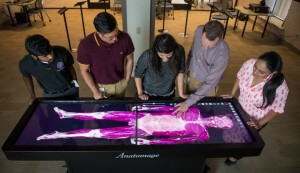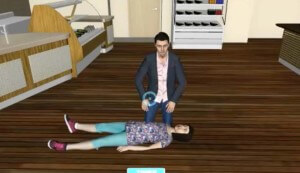Welcome to our recurring post, 3D Interactive Tech Talk, highlighting how interactive technology is being used right now and where it’s headed.
VR Technology Revolutionizing Health Sciences Learning

College of Dental Medicine students use the Anatomage Virtual Dissection Table in the new Virtual Reality Learning Center housed in the Harriet K. and Philip Pumerantz Library at Western University of Health Sciences Friday, Aug. 20. 2015. (Jeff Malet, WesternU)
Western University of Health Sciences in Pomona CA has raised the stakes in virtual training with a first-of-its-kind virtual reality learning center, consisting of four differing VR technologies, including Oculus Rift, and the Anatomage Virtual Dissection Table. These systems allow students to learn in a hands-on environment and “interact with anatomy in a way never before experienced,” says Robert W. Hasel, D.D.S., Western’s associate dean of simulation, immersion & digital learning. The virtual reality learning center draws its inspiration from video games, and allows for a flipped classroom model, where users can “practice in a virtual world before hands-on with the real world,” according to Gregg Yedwab, head of business development at zSpace.
Are VR Systems the Superior Method of Medical Training?
 Augmented and virtual reality company Next Galaxy Corp is joining the ranks of companies changing the way hospitals train medical personnel. VR is already proving to be a more effective method of medical training, according to Dr. Narendra Kini, CEO at Miami Children’s Health System – boasting significantly higher retention rates than traditional methods. Using VR technology also eliminates the need to practice on real people, which can prevent mishaps that lead to malpractice lawsuits. However, the most appealing aspect of VR may be its cost effectiveness. Elder-care facilities, as one example, can spend thousands of dollars training employees on specialized procedures like tracheal insertion. The price tag for VR training of the same procedure? On average, $40 per employee.
Augmented and virtual reality company Next Galaxy Corp is joining the ranks of companies changing the way hospitals train medical personnel. VR is already proving to be a more effective method of medical training, according to Dr. Narendra Kini, CEO at Miami Children’s Health System – boasting significantly higher retention rates than traditional methods. Using VR technology also eliminates the need to practice on real people, which can prevent mishaps that lead to malpractice lawsuits. However, the most appealing aspect of VR may be its cost effectiveness. Elder-care facilities, as one example, can spend thousands of dollars training employees on specialized procedures like tracheal insertion. The price tag for VR training of the same procedure? On average, $40 per employee.
Do you have a question regarding this technology? Hit us up here now to discuss how this could apply to your needs.
And check out our interactive training applications to see some of the many ways businesses are benefiting from this technology.


